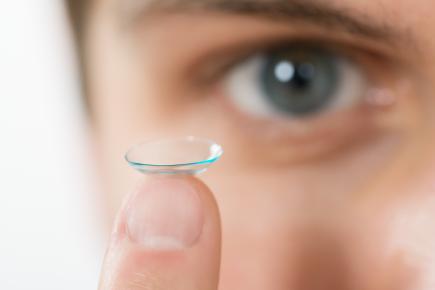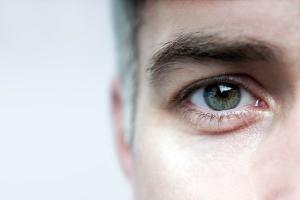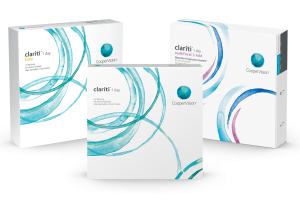
While many patients are satisfied and find long-time success in monthly or two-week replacement contact lens modalities, daily disposable contact lenses offer distinct benefits to the patient and the practice.1-4 Numerous studies point to daily disposables’ three key benefits: convenience, compliance, and ocular health.1-4
In a survey-based study of roughly 300 contact lens wearers, Rueff et. al found patients wearing daily disposable lenses were the most compliant compared to their counterparts in monthly and two-week replacement modalities.1 On the ocular health front, a major benefit of daily disposable lenses is fewer ocular complications, such as corneal infiltrative events, compared with reusable modalities.2,3 Daily disposables contact lenses also offer patients the convenience of not having to clean and disinfect their lenses after each use.2
ECPs are increasingly turning to daily disposable lenses to meet their patient and practice needs.5,6 In an international survey that tracked prescribing habits in 2023, eye care professionals prescribed more daily disposables than monthly or two-week replacement lenses, representing 45% to 40% of all soft contact lens fits, respectively.6
So how can you successfully migrate your monthly or two-week replacement CL wearing patients into daily disposables? The switch can be easily accomplished in a few simple steps, says Dr. Sahil Dosaj of Miller Optometry in Yucaipa, CA.
Initiate the Conversation with Every Monthly or Two-week Modality Wearer
At Dr. Dosaj’s practice, 93% of his contact lens patients are in daily disposable lenses. But that wasn’t always the case. Upon joining his practice and becoming a partner, Dr. Dosaj discovered every patient was wearing a two-week lens and for a month. This meant that the practice was losing revenue due to non-compliance in wearing time, and patients were developing frequent ocular surface issues.
“The answer was to switch patients over to daily disposables,” Dr. Dosaj says.
Step one in his daily disposable migration plan was to instruct staff to add five extra minutes to each contact lens patient visit so he could talk about daily disposables.
Show Pictures to Punctuate Your Point
Early on, Dr. Dosaj invested in an anterior segment camera which he used to capture clinical images that he would share with his contact lens patients, a routine that he still practices today.
“In the five minutes I built into the exam, I’d explain, ‘In your current lenses, your blood vessels aren’t normal due to lack of oxygen. Overwearing your contacts is doing this to your eyes. If the blood vessels cross over and continue to the center of your eye, your contact lens wear-time will decrease, and you eventually may not be able to wear contact lenses anymore.’ That’s the last thing a contact lens wearer wants to hear.”
Dr. Dosaj then explains the ocular health benefits2,3 of daily disposable lenses and gives the patient a pair of daily disposable trial lenses to test drive.
Address the Cost Question
Following the contact lens exam, all patients leave with a piece of paper that breaks down the annual supply cost, less the patient’s insurance and the manufacturer’s rebate. Factoring in the deductions, the final net cost per box is circled on the form.
“This way, when we follow up with them in two days, the patient already knows how much they’re going to pay for their contacts lenses,” Dr. Dosaj continues. “This also saves our staff a lot of time. When we follow up with the patient, the conversation is short and direct. The patient already knows what they’ll have to pay, and if they’ve shopped around online, they’ll also know that they won’t find a cost less than ours.”
Comparisons also go far when a patient brings up the additional cost of daily disposables, he adds. For example, Dr. Dosaj will tell the patient the overall cost may be more, but after the rebate and insurance, the average cost is only about $1.50 to $2 a day, which he reminds is less than the cost of buying a cup of coffee.
“When I say that, you see the twinkle in the patient’s eyes and the lightbulb go off in their head,” he says.
Share the Continuity of Technology and Design
For patients in the Biofinity® monthly replacement family of lenses, Dr. Dosaj makes sure to let them know that they can continue to enjoy many of the same technologies when they switch into a MyDay® daily disposable lens.
These continued benefits include:
- All-day comfort7 with Aquaform® Technology, which allows Biofinity® and MyDay® contact lenses to deliver an optimized balance of high oxygen permeability and water content, combined with optimum modulus, to provide high levels of breathability and moisture in a comfortable, flexible lens.7
- DigitalBoost™ Technology, found in both Biofinity Energys® and MyDay Energys®, which may help ease strain on eye muscles associated with digital device use so the wearer can shift focus from on screen to off with less effort.*8
- Optimized Toric Lens Geometry™ which results in a multifaceted toric lens that’s designed to provide predictable, consistent visual acuity, lens stability, fit and comfort for patients with astigmatism. Optimized Toric Lens Geometry™ is found in both Biofinity® toric and MyDay® toric lenses.
Empower Staff to Take the Baton
The ECP’s role is 50% of the daily disposable migration journey, and the other 50% is dependent on staff, Dr. Dosaj says.
“All our staff is highly trained,” he explains. “We constantly train with CooperVision reps and conduct our own in-office training. This gets our staff excited about new technology, and we have staff try new lenses on their eyes so they can share their firsthand experiences and feel confident while doing so.”
Reap the Benefits of Practice Growth
Switching patients to daily disposables provides health benefits2,3 and can help ensure the long- term wearing success of the patient, Dr. Dosaj says.
“Practices also need to look at their bottom line,” he continues. “At the end of day, we’re always looking out for the patient’s health. It’s our job to give them the best suggestion, but we’re also running a business, Daily disposables can be a practice builder. And you need to introduce new technology to patients. If you don’t, the doctor down the street probably will. That’s what’s going to set a practice apart and keep patients coming back.”
Find out more about CooperVision daily disposable lenses, including the MyDay® and clariti® 1 day families. You can also discover more learnings and resources at CooperVision’s Online Success Center.

Dr. Sahil Dosaj is the owner of Miller Optometry in Yucaipa, CA. He joined the practice in 2014 after graduating from Western University College of Optometry and completing his residency in ocular disease at the Indian Health Services Hospital in Crownpoint, New Mexico. Dr. Dosaj currently focuses on primary care, ocular disease, specialty contact lenses, and pre and post op care for LASIK and cataract surgery.








